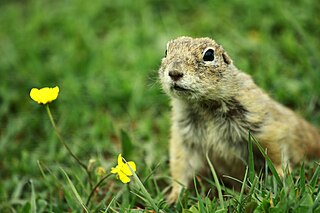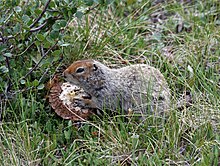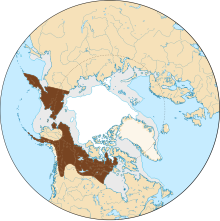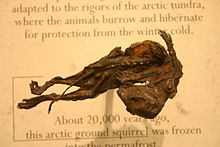
Hibernation is a state of minimal activity and metabolic depression undergone by some animal species. Hibernation is a seasonal heterothermy characterized by low body-temperature, slow breathing and heart-rate, and low metabolic rate. It most commonly occurs during winter months.

The California ground squirrel, also known as the Beechey ground squirrel, is a common and easily observed ground squirrel of the western United States and the Baja California Peninsula; it is common in Oregon and California and its range has relatively recently extended into Washington and northwestern Nevada. Formerly placed in Spermophilus, as Spermophilus beecheyi, it was reclassified in Otospermophilus in 2009, as it became clear that Spermophilus as previously defined was not a natural (monophyletic) group. A full species account was published for this species in 2016.

Ground squirrels are rodents of the squirrel family (Sciuridae) that generally live on the ground or in burrows, rather than in trees like the tree squirrels. The term is most often used for the medium-sized ground squirrels, as the larger ones are more commonly known as marmots or prairie dogs, while the smaller and less bushy-tailed ground squirrels tend to be known as chipmunks.

The northern Idaho ground squirrel is a species of the largest genus of ground squirrels. This species and the Southern Idaho ground squirrel were previously considered conspecific, together called the Idaho ground squirrel.

Spermophilus is a genus of ground squirrels in the squirrel family. As traditionally defined the genus was very species-rich, ranging through Europe, Asia and North America, but this arrangement was found to be paraphyletic to the certainly distinct prairie dogs, marmots, and antelope squirrels. As a consequence, all the former Spermophilus species of North America have been moved to other genera, leaving the European and Asian species as true Spermophilus.

Richardson's ground squirrel, also known as the dakrat or flickertail, is a North American ground squirrel in the genus Urocitellus. Like a number of other ground squirrels, they are sometimes called prairie dogs or gophers, though the latter name belongs more strictly to the pocket gophers of family Geomyidae, and the former to members of the genus Cynomys.

The hoary marmot is a species of marmot that inhabits the mountains of northwest North America. Hoary marmots live near the tree line on slopes with grasses and forbs to eat and rocky areas for cover.

Heterothermy or heterothermia is a physiological term for animals that vary between self-regulating their body temperature, and allowing the surrounding environment to affect it. In other words, they exhibit characteristics of both poikilothermy and homeothermy.

The Washington ground squirrel is near threatened species of squirrel distributed in the Pacific Northwest states of Washington and Oregon, United States.

The European ground squirrel, also known as the European souslik, is a species from the squirrel family, Sciuridae. It is among the few European species in the genus Spermophilus. Like all squirrels, it is a member of the rodent order. It is to be found in eastern and central Europe from southern Ukraine, to Asia Minor, Austria, the Czech Republic, Slovakia, Serbia, Greece, Romania, Bulgaria, North Macedonia and north as far as Poland but the range is divided in two parts by the Carpathian Mountains.

Belding's ground squirrel, also called pot gut, sage rat or picket-pin, is a squirrel that lives on mountains in the western United States. In California, it often is found at 6,500 to 11,800 feet (2,000–3,600 m) in meadows between Lake Tahoe and Kings Canyon. This species is not of conservation concern, and its range includes some protected areas.

The Uinta ground squirrel, commonly called a "chisler" and Potgut in northern Utah, is a species of rodent native to the western United States.

The Alaska marmot, also known as the Brooks Range marmot or the Brower's marmot, is a species of rodent in the family Sciuridae. Once considered to be the same species as the hoary marmot, it is now known to be unique. Alaska marmots are found in the scree slopes of the Brooks Range, Alaska. Specifically, they prefer to dwell on rocky, mountainous terrain, generally near lakes. They eat vegetation found on mountainsides, such as grasses, seeds, and lichen. Their relatively thick bodies are covered in dense, grey fur. They live in large colonies that consist of multiple families. During the winter, they hibernate for long periods of time in burrows. While not well researched, they are not believed to be particularly threatened, by human activity or otherwise. The Alaskan government has designated February 2 as "Marmot Day," a holiday intended to recognize the prevalence of marmots in the state, similar to the more widely celebrated American holiday of Groundhog Day.

The Columbian ground squirrel is a species of rodent common in certain regions of Canada and the northwestern United States. It is the second largest member of the genus Urocitellus, which is part of the tribe Marmotini, along with marmots, chipmunks, prairie dogs, and other holarctic ground squirrels. They are stout, with short dense fur, which is characteristically tawny across the bridge of the nose. Social encounters sometimes are initiated with kissing behavior and the most common activity above ground is standing at attention. Residing in mountainous terrain and high plains in northern latitudes, they hibernate for 8 to 9 months of the year in burrows, which may be used for many years. They are emaciated when emerging in the spring. The Columbian ground squirrel came to the attention of the scientific community through writings produced by Lewis and Clark, while 21st century molecular genetics has more finely illuminated its ties with other close relatives.

The little ground squirrel or little souslik, is a species of rodent in the family Sciuridae. It is found from Eastern Europe to Central Asia.

The spotted ground squirrel is a species of ground squirrel in the rodent family Sciuridae. It is found throughout Mexico and the central and western United States. Characterized by a white spotted back, the spotted ground squirrel is one of the smallest squirrels found in North America. They are mainly herbivorous, but also eat insects. A burrowing mammal, the spotted ground squirrel will make tunnels to store its food, as well as shelter and hibernation quarters.

Townsend's ground squirrel is a species of rodent in the family Sciuridae. It is found in high desert shrublands in several areas of the United States.

The Asia Minor ground squirrel, also known as Anatolian souslik, Anatolian ground squirrel, is a species of rodent in the family Sciuridae. It is found in Armenia, Iran, and Turkey. The scientific name roughly translates as "seed-lover with yellow underparts".

Urocitellus is a genus of ground squirrels. They were previously believed to belong to the much larger genus Spermophilus, but DNA sequencing of the cytochrome b gene showed that this group was paraphyletic to the prairie dogs and marmots, and could therefore no longer be retained as a single genus. As a result, Urocitellus is now considered as a genus in its own right.

The Arctic foothills tundra is an ecoregion of the far north of North America, lying inland from the north coast of Alaska. This is permafrost tundra with an average annual temperature below freezing.

























